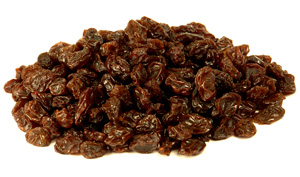 Raisins seem like a pretty innocent food. They don’t contain added sugars, artificial preservatives or unnatural food colorings. But should they be considered as good as grapes?
Raisins seem like a pretty innocent food. They don’t contain added sugars, artificial preservatives or unnatural food colorings. But should they be considered as good as grapes?
According to the 2025 Report of the Dietary Guidelines Advisory Committee, 75 percent of Americans (including men, women and children ages nine to 18) do not eat enough fruit on a daily basis. According to data from the Japanese research group Nippon Data 80/90, this statistic looks no better in twenty other first-world nations. The International Nut and Dried Fruit Council has put forward a paper titled “Valuable Tools to Meet Dietary Recommendations for Fruit Intake,” which suggests that dried fruit is “nutritionally equivalent” to fresh, and should be treated as such in government dietary recommendations and guidelines around the world.
On one hand, this paper is a lobbying tool, putting science and statistics at the hands of marketers to promote a product. On the other hand, it proposes a seemingly reasonable solution for over-fed yet malnourished populations. In fact, MyPlate materials already suggests that dried fruits, such as raisins, be considered for healthy snack.
However, the claim that dried fruits are “nutritionally equivalent” to fresh produce seems to be a stretch. Dried fruit is a good source of fiber and other vitamins, which varies by fruit. Dried plums are high in vitamin K, dried peaches and apricots are a good source of carotenoids and calcium. However, the drying process can destroy other vitamins, most notably vitamin C, a fairly unstable compound. “You can also lose some vitamin A and possibly B vitamins (like thiamin) and some minerals during the drying process,” added Elisa Zied, MS, RD, author of Nutrition At Your Fingertips.
 “The main difference, beyond the fact that the water has been removed, is that all the nutrients are more concentrated,” explains Daniel D. Gallaher, Ph.D., a Professor at the Department of Food Science and Nutrition at the University of Minnesota, who spoke to me on behalf of the California Dried Fruit Commission. “They’re more energy dense.” In other words, they have more calories. Specifically, they have lots of calories from sugar. “Removing the water also concentrates the sugar,” said Dr. Gallaher. “So, the sweetness will generally be more intense as well, that may be a factor that might cause one to over-consume if one has a sweet tooth.”
“The main difference, beyond the fact that the water has been removed, is that all the nutrients are more concentrated,” explains Daniel D. Gallaher, Ph.D., a Professor at the Department of Food Science and Nutrition at the University of Minnesota, who spoke to me on behalf of the California Dried Fruit Commission. “They’re more energy dense.” In other words, they have more calories. Specifically, they have lots of calories from sugar. “Removing the water also concentrates the sugar,” said Dr. Gallaher. “So, the sweetness will generally be more intense as well, that may be a factor that might cause one to over-consume if one has a sweet tooth.”
All sources stress the importance of portion control, particularly for those who want to lose weight or who may struggle to maintain a healthy weight. A serving of dried fruit needs to be proportionally reduced by the amount of water that has been lost. This means that dried fruit may be less filling. In fresh fruit, “the water does add some satiety factor,” said Dr. Gallaher. “Water when it’s in food, as opposed to a glass of water, does seem to influence the sensation of fullness. So, there is that potential for over-consumption of dried fruit compared to non-dried fruit.”
“Dieters should first and foremost turn to fresh fruit first since it’s high in water content, typically high in fiber, and can really fill you up without providing too many calories,” said Zied. “It’s perfectly fine to consume some dried fruit, but keep in mind it’s a very concentrated calorie source (the raisins have very little water content and more calories in a small portion–and you could have a relatively small portion of raisins or a relatively large portion of grapes for the same calorie load).” For people who are looking to lose weight, she recommends no more than one to two tablespoons on any one day, and suggests using them as a way to sweeten healthy foods like salads, yogurt or whole grain, high fiber cereals.
On an individual level, eating a moderate amount of dried fruit can be a convenient and tasty way to get an extra serving of fruit. There are certainly many, many snacks that are less healthy. Dr. Gallaher argues that despite the potential for over-consumption, the benefits outweigh the possible problems. “I really think that we should consider dried fruits as a good alternative to fresh fruits,” he concluded.
It’s at the policy level that I find the idea that dried fruits should hold an equal position to fresh fruit to be troublesome, as well as the fact that it’s being put forward by a group that stands to profit from that sort of national endorsement. Americans have not shown themselves to be good at eating in moderation. In a nation facing an obesity crisis and unprecedented levels of diabetes, pushing a food that’s high in calories from sugar is not an ideal policy choice.
Also Read:
Fruits with the Least and Most Amount of Sugar
How to Get More Fruit in Your Diet
Are Raw Foods Really Healthier? The Nutrition of Raw vs. Cooked
